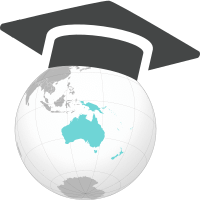Oceanian Universities World Representation
How many Universities are there in Oceania? According to the uniRank database in 2023 there are currently 62 officially recognized higher-education institutions in Oceania. Considering that the uniRank database includes a total number of 13,837 officially recognized higher education institutions the proportion of Oceanian Universities in the world is as follows:
-
uniRank Oceanian Universities World Representation Index: 0.45%
Being the estimated population of the Oceanian continent around 0.53% of the total world population (source: United Nations' World Population Prospects, the 2015 Revision), the Oceanian Higher education system and offerings seem to be fairly represented in the world at least in terms of the number of higher education institutions.
Public vs Private Universities in Oceania
How many public and private Universities are there in Oceania? Out of the total number of 62 recognized higher education institutions in Oceania included in the uniRank database, 56 (90.3%) are public (i.e. officially affiliated to or run by national, state or local governments) and 6 (9.7%) are private.
In terms of the number of public versus private Universities, the uniRank database shows a much higher presence of public higher education institutions in the Oceanian continent as a whole. Moreover, 47 (94%) out of the top 50 Universities in Oceania are public higher education institutions. Differences and peculiarities may still exist in each Oceanian country's higher education system.
Non-profit vs for-profit Universities in Oceania
What type of entities are Universities in Oceania? Out of the total number of 62 recognized higher education institutions in Oceania included in the uniRank database, 58 (93.5%) are non-profit and 1 (1.6%) is for-profit. The type of entity of the remaining Oceanian Universities included in the uniRank database is unknown or it has not been reported (4.9%). As a general rule, the vast majority of Oceanian public higher education institutions are not-for-profit organizations, not necessarily in legal terms but certainly in terms of nature and institutional purposes such as role, scope and mission.
Challenges for the higher education systems in Oceania
What are the main challenges that higher education in Oceania currently faces? According to uniRank the main issues of the higher education systems in Oceania include:
a) Access and affordability: many students in Oceania face barriers to accessing higher education due to financial, geographic and other factors. This is particularly true for students from disadvantaged backgrounds, rural areas or remote islands, where access to higher education can be limited.
b) Funding: funding is a major issue for higher education systems in Oceania. Many institutions struggle to secure enough funding to maintain their operations and offer competitive salaries to attract and retain talented faculty members.
c) Technology: technology plays an important role in higher education, but many institutions in Oceania struggle to keep up with the latest developments and integrate technology into teaching and learning effectively.
d) Indigenous education: many Indigenous students in Oceania face unique challenges in higher education, including cultural and linguistic barriers and a lack of understanding of Indigenous knowledge systems by non-Indigenous faculty.
Addressing these challenges will require a coordinated effort from governments, higher education institutions and other stakeholders in Oceania. Some possible solutions include increased funding, greater investment in infrastructure and technology and better support for Indigenous students.
Top 50 Universities in Oceania
uniRank publishes twice a year a non-academic university ranking of the top 50 Universities in Oceania based on valid, unbiased and non-influenceable web metrics provided by independent web intelligence sources. Please read the ranking methodology on the About Us page for more information.

 Australia
Australia